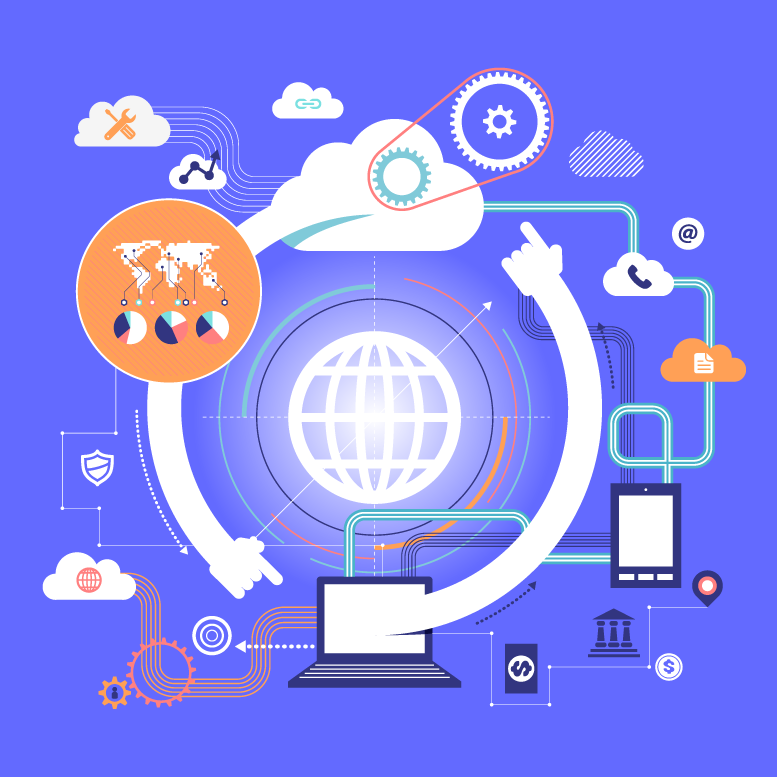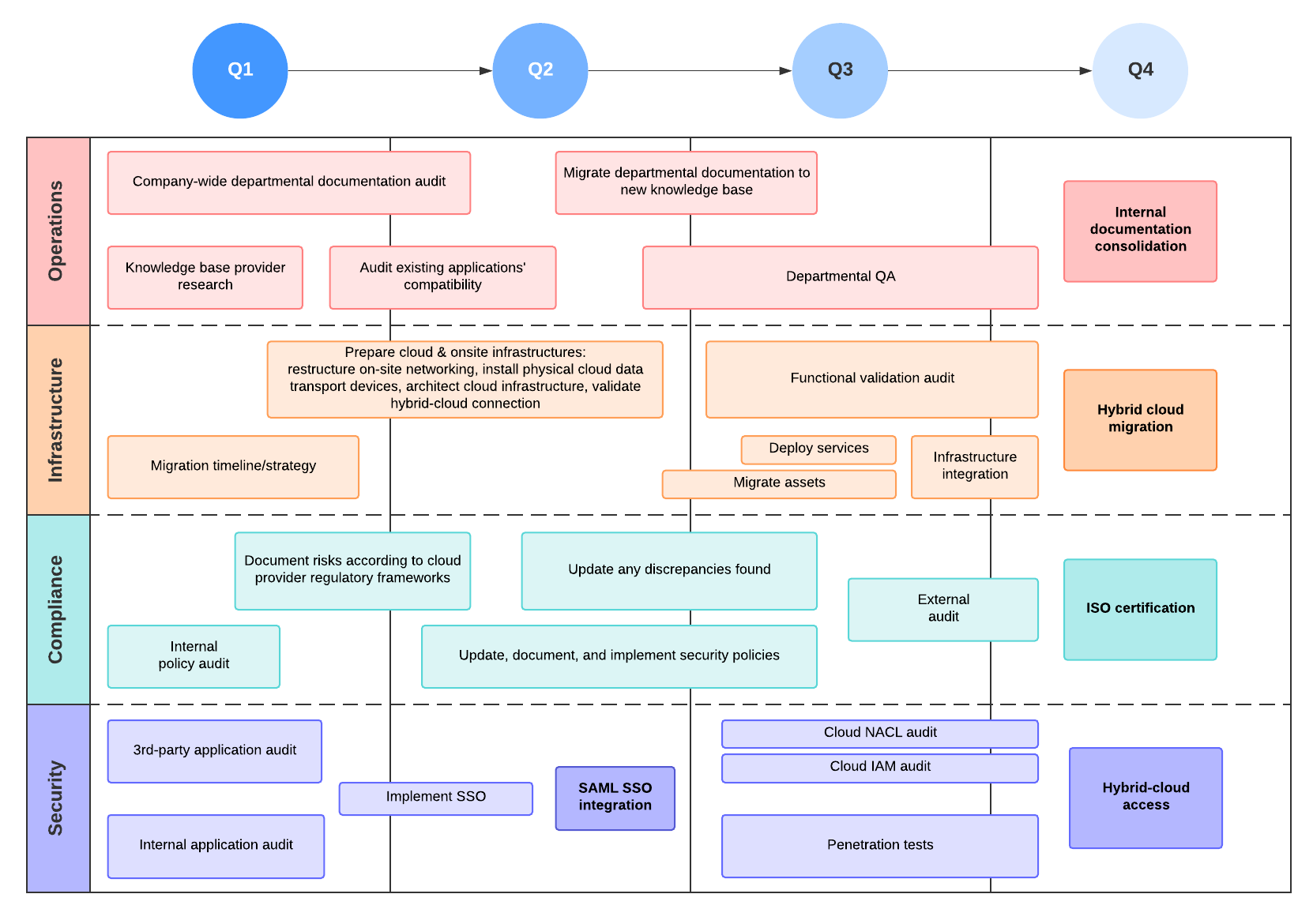As a business matures, what it needs to deliver a competitive product or service will grow and evolve. From personnel to workflow management to capital investment to emerging technologies and beyond, successful and sustainable businesses must adapt as their industry changes and the needs of their customers change.
The companies that fare best through these changes are the ones who forecast their industry’s evolution and make thorough plans accordingly. Planning for these changes can be a challenge—but with the right data, research, and most importantly, a clear roadmap, a company can not only survive downturns but thrive through them.
Perhaps the area of business that you'll need to update and project most accurately is how you'll use and apply available technologies. By improving work processes, delivering more accurate and useful data, and generally improving capability, technological advancement may be the best way to improve your business.
This article will focus on technology roadmaps—what they are and how they may be useful in planning a sustainable future for your business or organization.
What is a technology roadmap?
A technology roadmap is a display, document, or diagram that illustrates the technology adoption plan at a given organization. Technology roadmaps help business leaders plan and strategize when and why they will onboard certain technologies while avoiding expensive mistakes. Roadmaps can also plan for technologies becoming obsolete.
An effective technology roadmap should also outline a strategy to reach short- and long-term digital transformation goals, if applicable.
There are two main categories of technology roadmaps: tech roadmaps that generally show which technologies to use and stop using, and a subtype focusing on IT systems. Let’s go over both.
Technology roadmap
A technology roadmap illustrates the technology presently available and emphasizes scheduled improvements. A technology roadmap should also consider which technologies will become obsolete or are scheduled for end of life. For example, a technology roadmap will show when the previous system will sunset and when the new one will be implemented.
As organizations lay out their strategy and implementation to help execute on their vision, a technology roadmap will help them determine which technologies to invest in and how to implement them. Technology roadmaps should enable technological infrastructure improvements to meet both long-term and short-term targets of the business or organization in mind.
IT systems roadmap
An IT systems roadmap is a diagram or model designed to set the parameters that enable key functioning across the business or organization. An effective IT roadmap will lay out current IT capabilities, projected IT needs, and any improvements you plan in order to make to execute against your business strategy.
Generally, IT roadmaps communicate plans about the major systems that keep your business running. These systems include customer relationship management systems (CRM), enterprise resource planning systems (ERP), data analytics systems, identity management systems, cybersecurity systems, and more.
Why do you need a technology roadmap?
A technology roadmap's overall purpose is to align your target stakeholders, like IT, software engineering, operations executives, and even sales teams, by creating a course of action to onboard new technology solutions or to maintain existing ones.
This method helps teams visualize, prepare for, and execute the desired outcomes for the organization. Creating a thorough technology roadmap gives you the ability to:
- Have a clear picture of your company’s IT infrastructure abilities and how they align with business outcomes.
- Address any current IT issues.
- Cut costs by removing any unnecessary technologies and applications.
- Increase productivity by implementing technology that serves your immediate needs.
- Improve IT and cybersecurity.
- Avoid or mitigate against system failures by learning any weaknesses in your IT infrastructure.
- Resolve any conflicts around business priorities.
- Prepare for digital transformation.

Develop your digital transformation strategy to better prepare your company for the future.
Learn howKey components of a technology roadmap
The following are the eight key elements of a technology roadmap.
Goals
Your technology or IT roadmap should include both long-term and short-term goals that the business or organization wishes to achieve through the technology implementation. These goals focus on the business operations that the technology systems make possible, in addition to what the organization will need to invest to maintain the systems as the business continues to evolve.
New system capabilities
These are the new capabilities provided by the technology enhancement. As an example, adding a chatbot to a customer-facing platform like a website or mobile app will provide scalability and enhance both inbound and outbound marketing strategies. New system capabilities cover everything from CRM systems to cybersecurity systems and beyond.
Release plans
Release plans highlight the requirements to enhance the systems to support the new technology's capabilities. They are generally predictable and may be scheduled months in advance. You should share release plans throughout the business or organization.
Milestones
Milestones are the key benchmarks achieved in the technology onboarding process. When stakeholders track milestones, they can assess and understand the progress toward their long-term goals, plus evaluate the success of the new technology in achieving those goals. Milestones are usually tied to specific dates and function as performance checkpoints to ensure that the business or organization is on track to hit their projected outcomes.
Resources
Resources exhibit the time, capital, energy, and personnel needed to onboard new technologies and maintain existing technology systems. For example, IT teams must plan how to simultaneously roll out a new operating system while updating existing systems as needed. This cross-functionality creates a dependency between groups and teams and is aided by having a clear roadmap in place to maintain functionality.
Training
Whenever you roll out a new technology system, you need to include a training period to ensure that personnel adopt the new system efficiently. In fact, your technology roadmap should always account for training time, as training includes the guidance needed for internal teams to adopt and support a new system. Training can apply to onboarding new systems or updates on existing systems.
Risk factors
Risk factors describe the potential internal or external threats that may prevent successful implementation of new technologies. Risk factors may include limitations in the technology itself, difficulty adopting the new technology such as a substandard user interface, or market disruptions that affect the needs and goals of the business or organization.
Status reports
Status reports keep all relevant stakeholders abreast and informed of the progress of the new technology adoption. If a system implementation is delayed, this could create a domino effect of delays on every business unit dependent on that system.
For example, a logistics company onboarding new logistics software could have their delivery teams slowed down or even halted by a delayed onboarding process. Keeping team members in close communication is essential in technology roadmaps, and status reports solve this problem.
Technology/IT roadmap example
Now that you know what to include within your technology roadmap or IT roadmap, you need to know what this visual looks like. Organized like a Gantt chart or a product roadmap, your technology roadmap should show projects, broken down into various tasks, extending through the quarter or beyond.
Take a look at the technology roadmap example below, and click to open and customize it as a template.

Tips for creating a technology roadmap
A useful technology roadmap must carry these core traits. It should be:
Clear
Although you want to make sure that your technology or IT roadmap is thorough, including the key components discussed above, it should also be digestible. Minimize the amount of text on your initial view and color-code your tasks to make your technology roadmap understandable at a glance and provide clear explanations to best translate your strategy.
Realistic
Your IT or technology roadmap won’t be useful to anyone if it’s based on unreasonable deadlines or leaves out major tasks within your processes. Be realistic about how much work is involved, how long projects will take, and how much you can afford monetarily to take on as you add projects into your roadmap.
Easy to share
You will need to include various stakeholders as you develop and finalize your technology roadmap, including IT, product managers, project managers, operations, engineering, and legal. So it’s important to use a tool that allows you to easily collaborate with all these parties. A shareable technology roadmap will also help you communicate the established vision to anyone involved with execution, reducing any chances for future implementation problems.
Evolving
Technology roadmaps should align with your company’s strategy and objectives and help your IT department plan for the future—but that means that the roadmap will continuously change to match new initiatives and challenges.
Revisit your roadmap often, and update it to reflect any changes to projects or timelines. Better yet, consider using a cloud-based platform that will update changes immediately to truly make your technology roadmap a living document.
Technology roadmaps are a valuable tool for any business that relies on technological systems in their daily operations. Ultimately, its purpose is to align your key stakeholders by creating a clear course of action. Better prepare for the future by starting your own technology or IT roadmap now.

See our tips and tricks for building a technology or product roadmap in Lucidchart.
Learn moreAbout Lucidchart
Lucidchart, a cloud-based intelligent diagramming application, is a core component of Lucid Software's Visual Collaboration Suite. This intuitive, cloud-based solution empowers teams to collaborate in real-time to build flowcharts, mockups, UML diagrams, customer journey maps, and more. Lucidchart propels teams forward to build the future faster. Lucid is proud to serve top businesses around the world, including customers such as Google, GE, and NBC Universal, and 99% of the Fortune 500. Lucid partners with industry leaders, including Google, Atlassian, and Microsoft. Since its founding, Lucid has received numerous awards for its products, business, and workplace culture. For more information, visit lucidchart.com.

